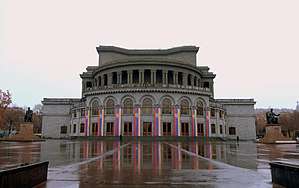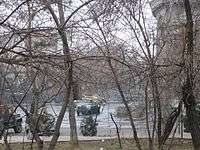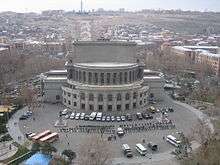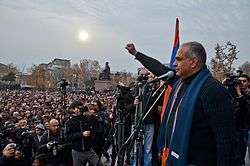Freedom Square, Yerevan
The Freedom Square or Liberty Square (Armenian: Ազատության հրապարակ, Azatut'yan hraparak), also known as Opera Square and Theatre Square (Թատերական հրապարակ, T'aterakan hraparak) until 1991, is a town square located in Kentron (Center) district of Yerevan, Armenia. The square is part of the Yerevan Opera Theater complex, located just to the south of the main opera building, between the opera park and the Swan lake. Along with the Republic Square, the Freedom Square is one of the two main squares in central Yerevan. It is bordered with four streets: Tumanyan Street, Teryan Street, Sayat Nova Avenue and Mashtots Avenue. The statues of writer Hovhannes Tumanyan and composer Alexander Spendiaryan are located in the square.

In politics
Due to a tradition of demonstrations at the square, it has been described as a "symbol of democracy" in Armenia.[1]
The square can hold an estimated 40,000,[2] 42,000–45,000[3] to 50,000 people.[4]
1988: Karabakh movement
The semi-circular square is known for its prominent role in modern history of Armenia. Since the Karabakh movement in February 1988, the Freedom Square has become a center of popular demonstrations. To suppress the demonstrations the square was closed down several times within 1988 by Soviet police and military forces.[5][6][7]
Post-election protests
After Armenia's independence in 1991 the square has been the main location of anti-government rallies, especially following presidential elections in 1996, 2003, 2008, and 2013.
In the aftermath of the disputed 2008 presidential election, thousands of supporters of opposition leader and Armenia's first president Levon Ter-Petrosyan gathered in the square and began sit-ins. In the early morning of March 1, 2008 these peaceful protests were violently dispersed by the police and the square was closed down for civilians.[8] For around 20 days, the square remained under occupation by police and armed forces to enforce the state of emergency. Subsequently, it was closed down for rallies for over three years, until March 17, 2011 when Ter-Petrosyan's Armenian National Congress staged a large rally.[9]
Underground parking lot
On August 28, 2008[10] the Armenian government made a decision to start a construction of an underground parking lot beneath the square to relieve the surrounding streets where parked cars often complicate the traffic. The opposition claimed the decision was intended to prevent demonstration there, although the government denied these allegations. The three-storey parking lot for up to 500 cars was opened on May 24, 2010 in attendance of Mayor Gagik Beglaryan and President Serzh Sargsyan. The project cost about $10.5 million.[11][12]
Gallery
.jpg) Karabakh movement, 1988
Karabakh movement, 1988 2008 Armenian presidential election protests: Thousands of protesters at Liberty Square on a typical evening (February 24)
2008 Armenian presidential election protests: Thousands of protesters at Liberty Square on a typical evening (February 24) 2008 protests: Tents set up
2008 protests: Tents set up 2008 protests: A water tanker cleans Opera Square of debris and blood after the government's crackdown
2008 protests: A water tanker cleans Opera Square of debris and blood after the government's crackdown 2008 protests: Riot police and army occupy and block access to Liberty Square as well as to other major squares in Yerevan, March 21
2008 protests: Riot police and army occupy and block access to Liberty Square as well as to other major squares in Yerevan, March 21
- 10.10.2014
References
- Abrahamyan, Gayane (16 September 2010). "Symbol of freedom or reminder of violence?: Opposition, city authorities continue battle over key Yerevan square". ArmeniaNow. Retrieved 12 November 2013.
The square, which is a symbol of democracy and victory going back to late Soviet times, was immediately turned into a construction site as the city began to build a huge underground parking garage.
- Pennington, Joseph. "FEB 9 TER-PETROSSIAN RALLY THE BIGGEST SO FAR THIS SEASON; UNREALIZE HOPES FOR OPPOSITION ALLIANCE, BUT PROMINENT VETERANS' GROUP MEMBERS ANNOUNCE SUPPORT". WikiLeaks. Embassy of the United States, Yerevan.
The local rule of thumb, which has aided us all year in our crowd estimations, is that Freedom Square has a maximum capacity of 40,000 people.
- "Ինչքան մարդ է տեղավորում Ազատության հրապարակը [How many people does the Freedom Square hold]". Aravot (in Armenian). 20 February 2013. Archived from the original on 22 March 2014.
Մեծ խտության դեպքում` մինչեւ 42-45 հազար մարդ` միայն ասֆալտին:
- Martirosyan, Ara (9 November 2008). Որքա՞ն միտինգավոր է տեղավորվում Ազատության հրապարակում. Azg Daily (in Armenian). Archived from the original on 22 March 2014.
Մի խոսքով, ներկայիս հանրահավաքների առավելագույն թիվը Ազատության հրապարակում կազմում է 50 հազար մարդ, քանի որ շրջակա տարածքները ներկայումս կառուցապատված են եւ այնտեղ մարդիկ գրեթե չեն լինում:
- Malkasian, Mark (1996). Gha-ra-bagh!: The Emergence of the National Democratic Movement in Armenia. Detroit: Wayne State Univ. Press. ISBN 9780814326046.
Residents awoke the next day [of 22 March 1988] to find Theater Square and the opera house ringed by fresh-faced soldiers..."
- "Troops Sent Back to Armenia Capital After Mass Rally". Los Angeles Times. 10 July 1988. Retrieved 1 April 2014.
- Keller, Bill (22 December 1988). "Armenia Opens To Show Capital Under Tight Lid". New York Times. Retrieved 1 April 2014.
The virtually nonstop, open-air political discussions that raged outside the city's neoclassical opera house have ended. The square beside the opera house is now ringed by tanks and troops, who wear bulletproof vests at nightfall.
- Tavernise, Sabrina (3 March 2008). "Emergency Order Empties Armenian Capital's Streets". New York Times. Archived from the original on 22 March 2014.
It was clear by early afternoon Saturday that after 10 days of peaceful protests, the demonstrators, who had been beaten by police officers in the morning, were spoiling for a fight.
- "Armenian Opposition Reoccupies Key Square As Protests Grow In Strength". Radio Free Europe/Radio Liberty. 18 March 2011. Retrieved 27 May 2013.
- Ազատության հրապարակը վերադարձվեց երևանցիներին` 500-տեղանոց ավտոկանգառով. panorama.am (in Armenian). 24 May 2010. Archived from the original on 14 November 2014.
- "New Underground Parking Structure Inaugurated in Armenian Capital". Asbarez. 24 May 2010.
- "The Underground Parking Lot of the Freedom Square opened with Participation of the Armenian President". Armenpress. 24 May 2010. Archived from the original on 14 November 2014.